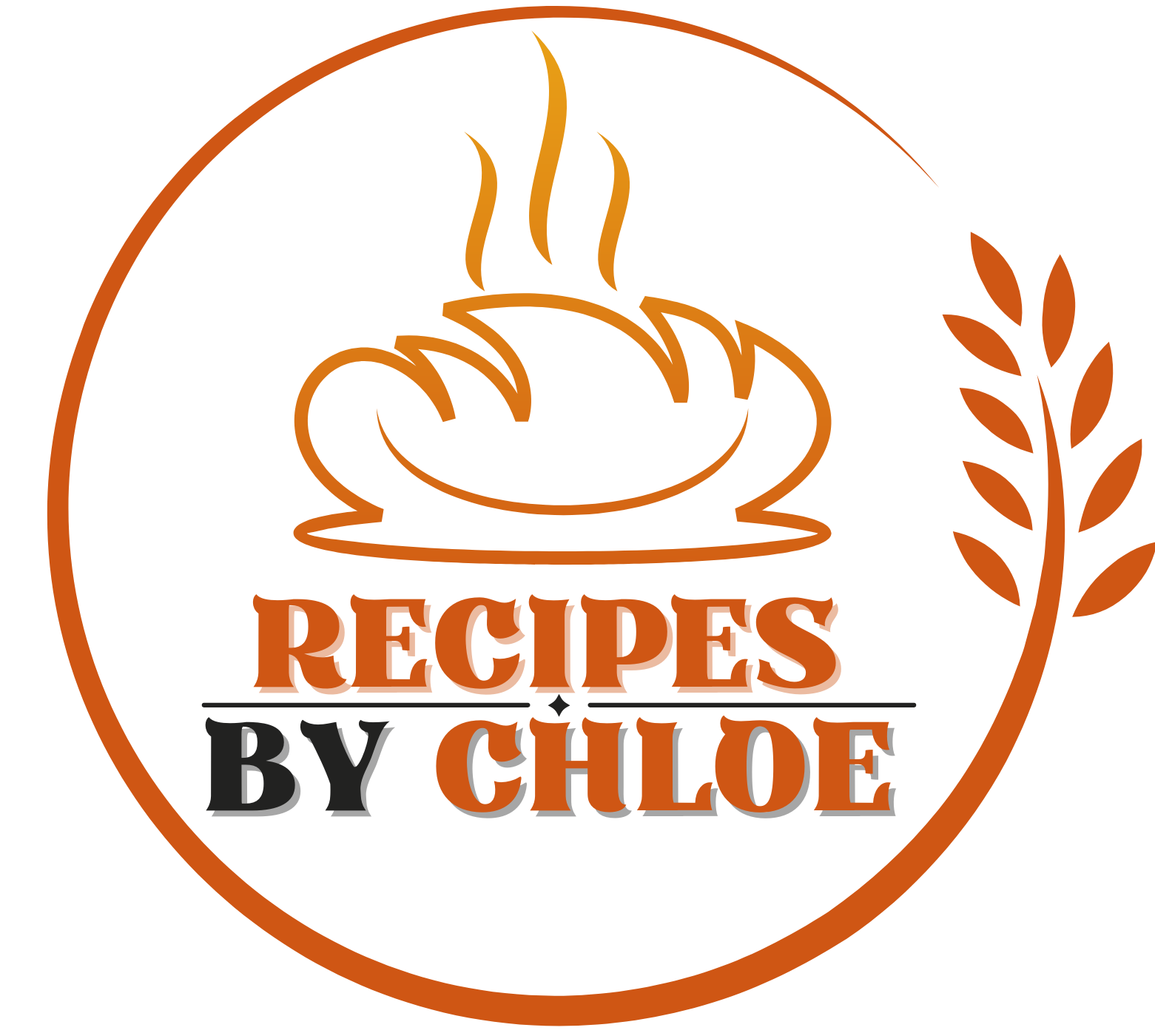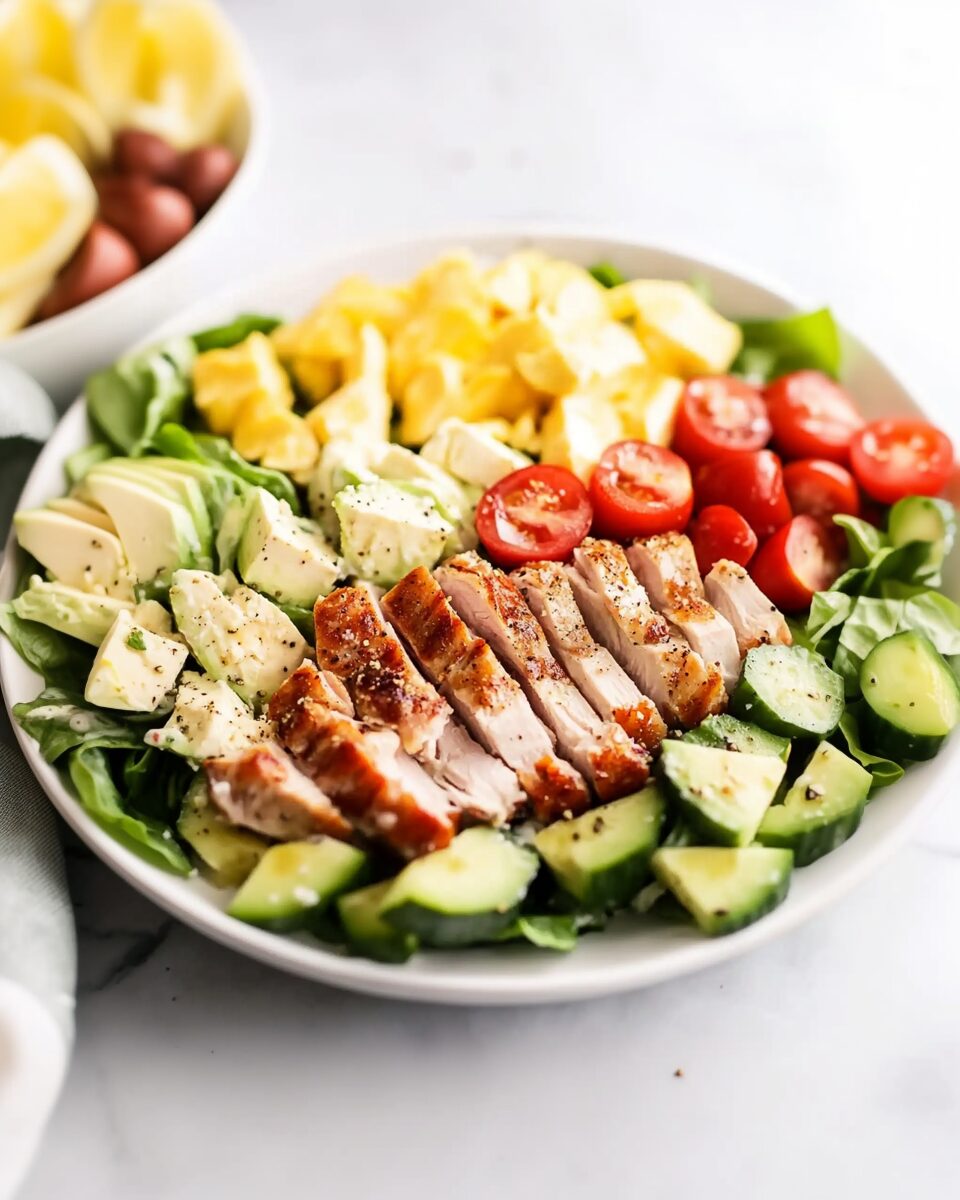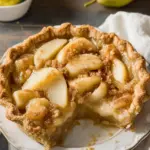The Cobb Salad is a classic American dish that combines fresh greens with hearty proteins, making it a wholesome and satisfying meal. Created by Robert Cobb, the owner of the Brown Derby restaurant in Los Angeles, this salad was originally made from leftovers and has since become a staple in American cuisine. It’s perfect for a summer lunch or a light dinner and can be prepared in under 30 minutes.
Full Recipe:
Ingredients
4 cups Romaine lettuce, chopped
½ cup cherry tomatoes, halved
1 avocado, sliced
6 oz boneless chicken breast, cooked and sliced
4 slices bacon, cooked and crumbled
4 oz crumbled Roquefort cheese (optional)
2 hard-boiled eggs, quartered
Chopped fresh chives, for garnish
For the dressing:
3 tablespoons olive oil
1 tablespoon white wine vinegar
1 teaspoon Dijon mustard
1 teaspoon honey
Salt and freshly ground black pepper, to taste
Directions
-
In a small bowl, whisk together the olive oil, white wine vinegar, Dijon mustard, honey, salt, and pepper to create the dressing. Set aside.
-
Arrange the chopped Romaine lettuce on a large serving platter or in a large bowl.
-
Neatly arrange rows of sliced chicken, crumbled bacon, halved cherry tomatoes, sliced avocado, quartered hard-boiled eggs, and crumbled Roquefort cheese over the lettuce.
-
Drizzle the prepared dressing evenly over the salad.
-
Garnish with chopped fresh chives.
-
Serve immediately and enjoy!
Nutritional Facts
Per serving (based on 4 servings):
Calories: 450
Total Fat: 30g
Saturated Fat: 7g
Cholesterol: 220mg
Sodium: 650mg
Total Carbohydrates: 12g
Dietary Fiber: 6g
Sugars: 3g
Protein: 35g
Origins of the Cobb Salad
The inception of the Cobb Salad is steeped in culinary folklore, tracing back to the late 1930s at the Hollywood Brown Derby restaurant in California. The salad is named after Robert Howard Cobb, the restaurant’s proprietor. According to popular accounts, Cobb, seeking a late-night meal, combined various leftovers from the kitchen, including lettuce, tomatoes, bacon, chicken, hard-boiled eggs, avocado, chives, and blue cheese, all tossed in a red wine vinaigrette. This impromptu creation not only satisfied his hunger but also captivated the taste buds of Hollywood’s elite, cementing its place in American cuisine.
Evolution and Variations
Over the years, the Cobb Salad has undergone numerous transformations, adapting to regional tastes and dietary preferences. While the core ingredients remain consistent, variations have emerged:
-
Protein Choices: Some renditions substitute grilled turkey or ham for chicken, offering a different flavor profile.
-
Cheese Options: Beyond the traditional Roquefort, alternatives like cheddar or Monterey Jack are sometimes used.
-
Dressing Variations: While red wine vinaigrette remains classic, some versions incorporate balsamic vinaigrette or even creamy dressings to suit diverse palates.
These adaptations showcase the salad’s versatility, allowing it to remain a staple in various culinary settings.
Nutritional Profile
The Cobb Salad is renowned not only for its delightful taste but also for its substantial nutritional content. Each ingredient contributes uniquely to the overall health benefits:
-
Protein: The inclusion of chicken and eggs provides high-quality protein essential for muscle repair and growth.
-
Healthy Fats: Avocado offers monounsaturated fats, which are beneficial for heart health.
-
Vitamins and Minerals: Leafy greens like romaine lettuce supply vitamins A and K, while tomatoes add vitamin C and potassium.
-
Fiber: The combination of vegetables and avocado contributes dietary fiber, aiding in digestion and promoting satiety.
However, it’s important to note that traditional Cobb Salad can be high in calories and saturated fats, primarily due to ingredients like bacon and blue cheese. Mindful portioning and ingredient substitutions can enhance its healthfulness.
Health Considerations and Modifications
For those seeking a healthier rendition of the classic Cobb Salad, several modifications can be made:
-
Lean Proteins: Opting for grilled chicken breast or turkey bacon reduces saturated fat intake.
-
Cheese Alternatives: Using reduced-fat cheese or decreasing the quantity can lower calorie content.
-
Increased Vegetables: Adding more leafy greens and other colorful vegetables enhances fiber and nutrient density.
-
Lighter Dressings: Choosing a light vinaigrette or a yogurt-based dressing can decrease overall fat content while maintaining flavor.
Implementing these adjustments allows individuals to enjoy the rich flavors of Cobb Salad while aligning with their dietary goals.
Perfect for Meal Prep and Entertaining
One of the reasons Cobb Salad remains a favorite among home cooks is its ease of preparation and suitability for meal planning. Since most of the components—such as cooked chicken, hard-boiled eggs, and pre-chopped vegetables—can be prepped in advance, it makes for a quick assembly during a busy week. Additionally, it serves as an elegant yet casual offering for entertaining guests. Served on a platter or in a clear glass bowl, the colorful arrangement of ingredients is visually appealing, making it an impressive yet simple option for dinner parties or potlucks.
Diet-Friendly and Customizable
Another major benefit of Cobb Salad is its alignment with several popular dietary lifestyles. It’s naturally low in carbs, making it keto-friendly, and with slight adjustments, it can be adapted to fit paleo or Whole30 diets. Those following vegetarian or even vegan diets can substitute plant-based proteins like grilled tofu, tempeh, or legumes and opt for vegan cheeses and dressings. This adaptability is a testament to the salad’s modern-day relevance as more people seek meals that align with their nutritional needs without sacrificing taste or satisfaction.
Why Cobb Salad Still Matters Today
In an age where food trends come and go quickly, the continued popularity of the Cobb Salad is a testament to its lasting value. It offers a satisfying balance of textures—crispy, creamy, crunchy—and flavors ranging from salty to tangy and savory. It speaks to both comfort and nourishment, making it suitable for both indulgent and health-conscious eating. As more people turn to fresh, whole foods and balanced meals, the Cobb Salad stands out as a dish that manages to be indulgent yet nutritious, traditional yet modern.
Cobb Salad in Popular Culture
The Cobb Salad’s association with Hollywood has cemented its status as a symbol of classic American dining. Its creation at the Brown Derby restaurant, a hotspot for celebrities during Hollywood’s Golden Age, contributed to its widespread acclaim. The salad’s appeal transcended the restaurant, appearing in various cookbooks, culinary shows, and even making its way into popular media, further solidifying its iconic status.
Conclusion
The Cobb Salad exemplifies the beauty of culinary creativity, transforming simple ingredients into a dish celebrated for its flavor, versatility, and nutritional value. Its rich history, rooted in an impromptu kitchen creation, has evolved into a beloved staple in American cuisine.






